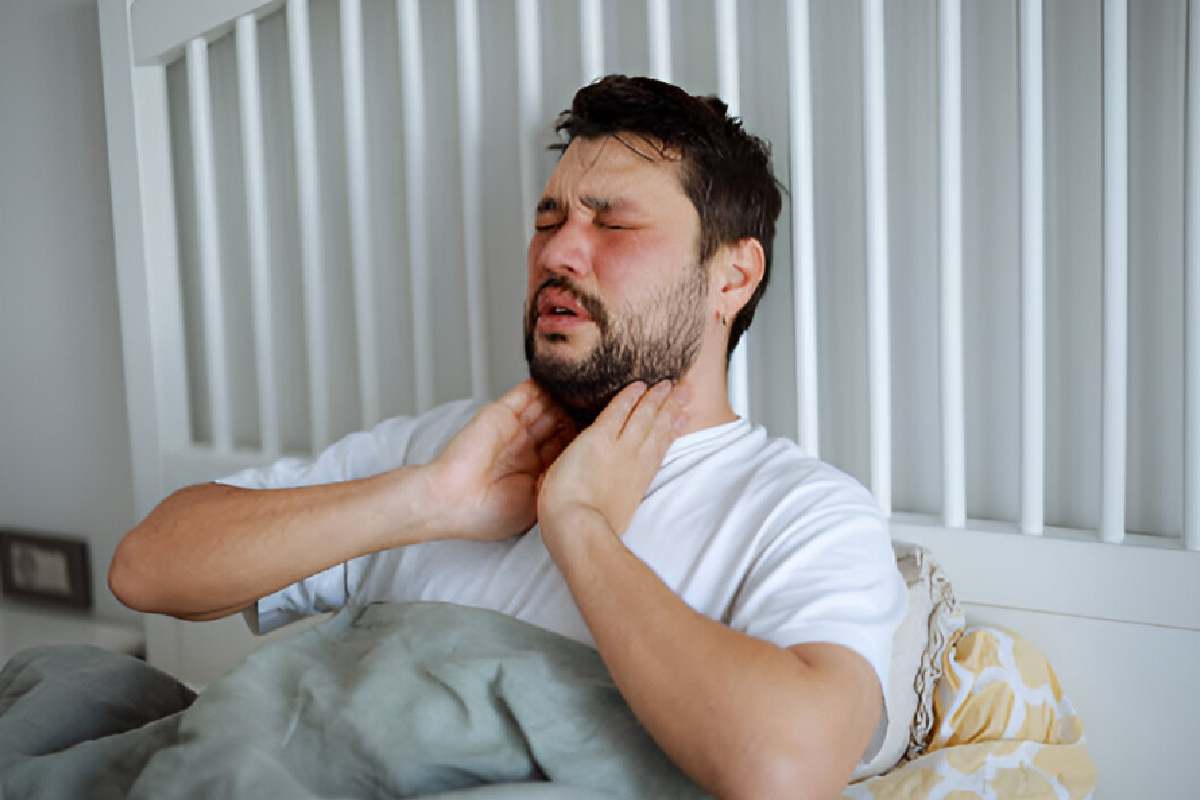Waking up with a sore throat on just one side can feel strange and worrying. Unlike a typical sore throat that affects both sides, one-sided pain may point to specific causes. It might be something minor, like sleeping with your mouth open or mild irritation, or it could signal infections such as tonsillitis, strep throat, or even dental issues. Understanding why it happens helps you know when simple home care is enough and when a doctor’s visit is needed.
Table of Contents
Possible Causes of One-Sided Sore Throat
1. Tonsillitis (Unilateral)
Inflammation or infection of one tonsil.
Caused by viral or bacterial infection.
Symptoms: red, swollen tonsil on one side, difficulty swallowing, fever.
May appear with pus spots or white patches.
2. Peritonsillar Abscess
A pocket of pus forms near one tonsil.
Usually follows untreated or severe tonsillitis.
Pain is intense and localized to one side.
Symptoms: difficulty opening mouth, swelling, ear pain on one side, muffled voice.
Requires urgent medical attention and drainage.
3. Post-nasal Drip (From Sinus Infection)
Mucus draining from sinuses can irritate one side of the throat.
Often worse in the morning after sleeping.
Associated with allergies or sinusitis.
Common symptoms: nasal congestion, sneezing, sore throat on one side.
4. Sleep Position
Sleeping on one side may lead to mouth breathing on that side.
Dry air or snoring irritates one side of the throat.
No fever or systemic symptoms.
Pain improves after drinking water or changing sleep position.
5. Dental Issues
Infected tooth, abscess, or impacted wisdom tooth can radiate pain to the throat.
Especially near the jaw or tonsil area.
Pain worsens while chewing or touching the affected tooth.
May also cause swelling of cheek or gums.
6. Lymph Node Swelling
Swollen lymph nodes due to localized infection (throat, ear, or skin).
Tender or painful on one side.
Often accompanied by fatigue or low-grade fever.
7. Pharyngitis
Inflammation of the pharynx (back of the throat).
Can be more pronounced on one side.
Viral or bacterial causes.
Symptoms: raw throat, pain while swallowing, scratchy feeling.
8. Ear Infection (Otitis Media or Externa)
Infection in middle or outer ear can radiate pain to the throat.
Especially if it’s on the same side.
Ear pain, discharge, and hearing loss may also be present.
9. Acid Reflux (LPR or GERD)
Stomach acid backing up into throat, more at night.
May affect one side more due to sleeping angle.
Associated with heartburn, sour taste, cough, hoarseness.
10. Injury or Irritation
Scratches from hard food (e.g., chips, bones) may cause localized sore throat.
Hot liquids or spicy foods can burn one side.
Toothbrush injury or sharp object (fish bone) can also damage the tissue.
11. Foreign Body in Throat
Food particles or sharp objects may get stuck on one side.
Causes pain, irritation, or gagging feeling.
May require medical removal if not dislodged naturally.
12. Tumors or Growths (Rare)
Benign or malignant growth in the throat or tonsil.
Causes persistent one-sided sore throat.
Often without infection symptoms like fever.
Warning signs: unexplained weight loss, hoarseness, bleeding, lump in neck.
13. Smoking or Vaping Irritation
Smoke exposure irritates throat lining.
Can be one-sided depending on airflow or position while smoking.
Dryness, chronic cough, or phlegm may also be present.
Associated Symptoms to Monitor
1. Fever
Suggests infection or inflammation.
High-grade fever may point to bacterial cause.
2. Earache
Often linked to throat issues via shared nerves.
May indicate tonsillitis or ear infection.
3. Difficulty Swallowing
Seen in abscesses or severe inflammation.
May need soft diet or antibiotics.
4. Swollen Lymph Nodes
Located under jaw or neck.
Painful or tender during infections.
5. Voice Changes
Hoarseness or muffled speech.
May occur with abscess, reflux, or tumors.
6. Cough or Nasal Symptoms
Points toward upper respiratory infection or allergies.
Post-nasal drip commonly affects the throat.
7. Bad Breath
Indicates possible infection, abscess, or poor dental hygiene.
8. Fatigue or Body Aches
Common with viral infections like flu, cold, or mono.
Diagnosis Methods
1. Throat Swab
For detecting bacterial causes (e.g., streptococcus)
2. Physical Examination
Inspection of tonsils, mouth, ears, and neck.
3. Blood Tests
CBC or monospot test if viral cause suspected.
4. Imaging (If Needed)
CT scan or ultrasound for abscess or mass.
5. Dental Check
If dental infection or jaw issue suspected.
Treatment Options
1. Warm Salt Water Gargles
Soothes pain and reduces inflammation.
Use 3–4 times daily.
2. Stay Hydrated
Keeps throat moist and helps clear infection.
3. Pain Relievers
Paracetamol or ibuprofen for relief.
Reduces swelling and pain.
4. Throat Lozenges / Sprays
Provide temporary relief.
Often contain antiseptic or numbing agents.
5. Antibiotics (If Bacterial)
Prescribed after confirmed diagnosis.
Complete full course as directed.
6. Antacids or Reflux Medications
For acid reflux-related sore throat.
Avoid eating late at night.
7. Nasal Sprays or Antihistamines
For allergy or sinus-related post-nasal drip.
8. Surgical Drainage (If Abscess)
ENT specialist may perform if abscess is present.
Sometimes done under local anesthesia.
9. Avoid Smoking and Irritants
Let throat heal faster.
Use air humidifier for dry environments.
10. Soft Diet
Avoid spicy, rough, or very hot foods.
Eat soups, yogurt, soft rice, or porridge.
When to See a Doctor
1. Severe or Worsening Pain
Especially if unable to swallow or breathe properly.
2. High Fever Over 101°F (38.3°C)
May indicate serious infection.
3. Swelling on One Side of Neck or Face
Could be sign of abscess or lymph node infection.
4. Muffled Voice or Drooling
Sign of obstruction or abscess needing immediate care.
5. Symptoms Lasting More Than a Week
Persistent pain should be evaluated.
6. Ear Pain Without Infection
May be referred from throat issues.
7. Unexplained Weight Loss or Lump
May require imaging or biopsy.
Prevention Tips
1. Practice Good Oral Hygiene
Brush and floss regularly.
Rinse after meals.
2. Avoid Sharing Food or Drinks
Reduces spread of infections.
3. Stay Away from Smoke and Pollution
Prevents throat irritation.
4. Use a Humidifier at Night
Keeps throat moist during sleep.
5. Treat Acid Reflux Promptly
Avoid spicy foods, late dinners, and lying down after meals.
6. Keep Immunity Strong
Balanced diet, exercise, and sleep help prevent infections.
7. Use Protective Masks During Allergies
Especially during pollen seasons or while cleaning dusty areas.
Conclusion
Waking up with a sore throat on one side is common and usually manageable.
Most causes are minor infections, posture issues, or allergies.
But symptoms like swelling, high fever, or pus need medical attention.
Identifying the cause helps with faster and effective treatment.
Simple home care, hydration, and timely check-ups can make a big difference.

